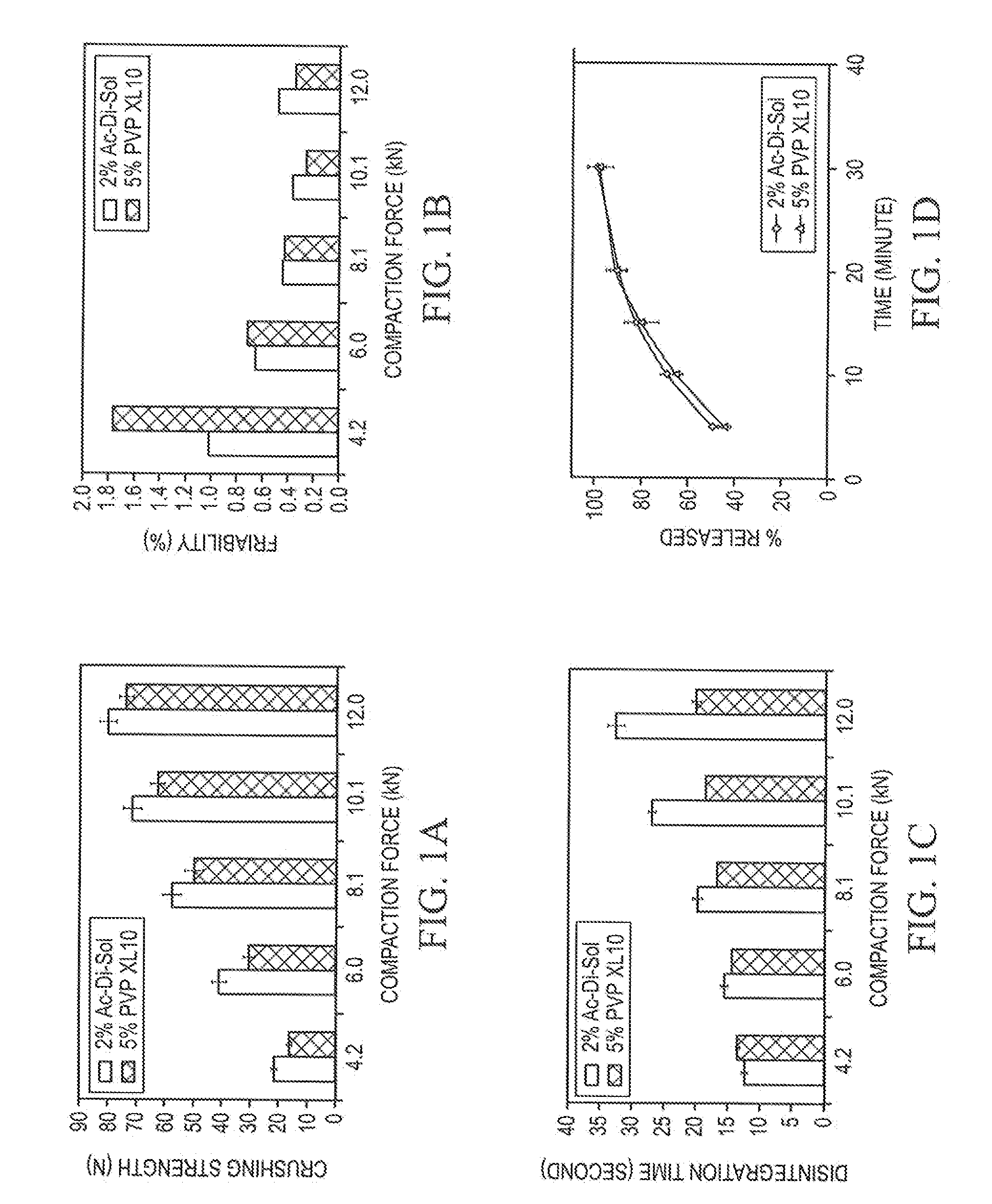Stable Orally Disintegrating Tablets Having Low Superdisintegrant
a superdisintegrant and tablet technology, applied in the field of oral disintegration tablets (odt), can solve the problems of poor consumer or patient acceptance, inadequate combination of properties of odts made with low levels of superdisintegrants, and several shortcomings of current odts made with inorganic fillers
- Summary
- Abstract
- Description
- Claims
- Application Information
AI Technical Summary
Benefits of technology
Problems solved by technology
Method used
Image
Examples
example 1
Materials
[0060]Spray-dried mannitol was obtained as Pearlitol® 200 SD from Roquette (Paris, France) which is a direct compressible mannitol, and was used as an ODT matrix. Magnesium stearate (Mallinckrodt, Hazelwood, Mo.) was used as a lubricant.
[0061]Table 1 shows three commercial superdisintegrants available from four suppliers. Lot TN07817522 of Ac-Di-Sol, which has a D50 of 42.5, was used in the examples, except that lot TN09820342 was used in the small ODT and flavor examples. Other gradesand types of superdisintegrants can be used, which differ in physical properties, such as particle size.
TABLE 1Commercial superdisintegrantsCategoryCommercial nameSupplierCroscarmelloseAc-Di-Sol ®FMC CorporationCrospovidonePolyplasdone ® XL-10 (PVP XL-10)ISP, Inc.Kollidon ® CL-SFBASFSodium StarchGlycolys ®RoquetteGlycolate
example 2
Preparation of ODTs
[0062]To prepare each formulation, Pearlitol® 200 SD and disintegrant, were weighed and premixed in a V-blender for 15 minutes; then magnesium stearate was added and followed up with additional 2 minutes of mixing. The ODTs had the specified amount of superdisintegrant, 1.5% (wt / wt) magnesium stearate, and the balance spray dried mannitol.
[0063]To prepare ODTs, each formulation was compressed individually on a Stokes 512 Tablet Press with four stations. Standard 7 / 16″ concave punches and corresponding dies were used. ODT weight was adjusted to 400 mg. SMI Director™ data acquisition system was used to record the compaction process. Compaction forces of 4 kN, 6 kN, 8 kN, 10 kN, or 12 kN were applied to the formulations to produce ODTs with different hardness.
example 3
Characterization of ODTs
[0064]Disintegration times of ODTs were determined using a Hanson QC-21 disintegration test system. The test was conducted at 37±0.5° C. in a medium of 10 mL distilled water. Six ODTs per sample were analyzed and the mean is reported.
[0065]Hardness along with ODT weight, thickness, and diameter were determined using an AT4 automatic tablet-testing system (Dr. Schleuniger Pharmatron, Switzerland). The hardness data are reported as the mean hardness of ten individual determinations. ODT weight and thickness were controlled in a very tight range.
[0066]ODT friability was measured on a VanKel Friabilator rotated at 25 rpm for 5 minutes. Twenty ODTs per sample were randomly selected for the study. The friability for each sample was calculated using following equation:
Friability (%)=(Wb−Wa) / Wb×100
where Wb and Wa are the weights before and after friability test.
[0067]All initial ODT characterization studies (hardness, disintegration time, and friability) were perform...
PUM
 Login to View More
Login to View More Abstract
Description
Claims
Application Information
 Login to View More
Login to View More - R&D
- Intellectual Property
- Life Sciences
- Materials
- Tech Scout
- Unparalleled Data Quality
- Higher Quality Content
- 60% Fewer Hallucinations
Browse by: Latest US Patents, China's latest patents, Technical Efficacy Thesaurus, Application Domain, Technology Topic, Popular Technical Reports.
© 2025 PatSnap. All rights reserved.Legal|Privacy policy|Modern Slavery Act Transparency Statement|Sitemap|About US| Contact US: help@patsnap.com



